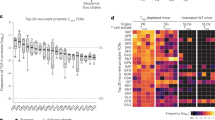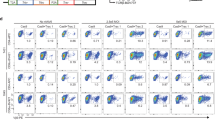Abstract
T-CELL differentiation in the thymus is thought to involve a progression from the CD4−CD8− phenotype through CD4+CD8+ intermediates to mature CD4+ or CD8+ cells1-3. There is evidence that during this process T cells bearing receptors potentially reactive to 'self are deleted by a process termed 'negative selection'4-10. One example of this process occurs in mice carrying polymorphic Mis antigens, against which a detectable proportion of T cells are autoreactive. These mice show clonal deletion of thymic and peripheral T-cell subsets that express the autoreactive Vβ3 segment of the T-cell antigen receptor, but at most a two-fold depletion of thymic cells at the CD4+CD8+ stage5-7. By contrast, transgenic mice bearing both α and β chain genes encoding autoreactive receptors recognizing other ligands, show severe depletion of CD4+CD8+ thymocytes as well8,9, suggesting that negative selection occurs much earlier. We report here the Mis 2a/3a mediated elimination of T cells expressing a transgene encoded Vβ3-segment, in T-cell receptor α/β and β-transgenic mice. Severe depletion of CD4+CD8+ thymocytes is seen only in the α/β chain transgenic mice, whereas both strains delete mature Vβ3 bearing CD4+ and CD8+ T cells efficiently. We conclude that severe CD4+CD8 thymocyte deletion in α/β transgenic mice results from the premature expression of both receptor chains, and does not reflect a difference in the timing or mechanism of negative selection for Mis antigens5-7 as against the allo- and MHC class 1-restricted antigens used in the other studies8-9.
This is a preview of subscription content, access via your institution
Access options
Subscribe to this journal
Receive 51 print issues and online access
$199.00 per year
only $3.90 per issue
Buy this article
- Purchase on Springer Link
- Instant access to full article PDF
Prices may be subject to local taxes which are calculated during checkout
Similar content being viewed by others
References
Guidos, C. et al. Proc. natn. Acad. Sci. U.S.A. (in the press).
Fowlkes, B. J., Edison, L., Mathieson, B. J. & Chused, T. M. J. exp. Med 162, 802–822 (1985).
Smith, L. Nature 326, 798–800 (1987).
Kappler, J. W. et al. Cell 49, 263–271 (1987).
Kappler, J., Staerz, U., White, J. & Marrack, P. Nature 332, 35–40 (1988).
MacDonald, H. R. et al. Nature 332, 40–45 (1988).
Pullen, A. M., Marrack, P. & Kappler, J. W. Nature 335, 796–801 (1988).
Kisielow, P., Bluthmann, H., Staerz, U. D., Steinmetz, M. & von Boehmer, H. Nature 333, 742–746 (1988).
Sha, W. C. et al. Nature 336, 73–76 (1988).
Pircher, H. et al. EMBO J. 8, 719–727 (1989).
Ivars, F. et al. in The T Cell Receptors (eds Davis, M. M. & Kappler. J.) 184–197 (Liss, New York, 1987).
Berg, L. J. et al. Molec. cell Biol. 8, 5459–5469 (1988).
Berg, L. J. et al. Cell (in the press).
Hedrick, S. M. et al. Cell 30, 141–152 (1982).
Abe, R., Vacchio, M. S., Fox, B. & Hodes, R. J. Nature 335, 827–830 (1988).
Fry, A. M. & Matis, L. A. Nature 335, 830–832 (1988).
Pullen, A. M., Marrack, P. & Kappler, J. W. J. Immun. 142, 3033–3037 (1989).
White, J. et al. Cell 56, 27–35 (1989).
McDuffie, M., Born, W., Marrack, P. & Kappler, J. W. Proc. natn. Acad. Sci. U.S.A. 83, 8728–8732 (1986).
Fowlkes, B. J., Schwartz, R. H. & Pardoll, D. M. Nature 334, 620–623 (1988).
MacDonald, H. R., Hengartner, H. & Pedrazzini, T. Nature 335, 174–176 (1988).
Finkel, T. H., Marrack, P., Kappler, J. W., Kubo, R. T. & Cambier, J. C. J. Immun. 142, 3006–3012 (1989).
Kappler, J., Roehm, N. & Marrack, P. Cell 49, 273–280 (1987).
Dialynas, D. P. J. Immun. 131, 2445–2451 (1984).
Ledbetter, J. A. & Herzenberg, L. A. Immunol. Rev. 47, 63–90 (1979).
Hayakawa, K., Hardy, R. R., Parks, D. R., Herzenberg, L. A. & Herzenberg, L. A., J. exp. Med. 157, 202–218 (1983).
Havran, W. L. et al. Nature 330, 170–173 (1987).
Author information
Authors and Affiliations
Rights and permissions
About this article
Cite this article
Berg, L., de St. Groth, B., Pullen, A. et al. Phenotypic differences between αβ versus β T-cell receptor transgenic mice undergoing negative selection. Nature 340, 559–562 (1989). https://doi.org/10.1038/340559a0
Received:
Accepted:
Issue Date:
DOI: https://doi.org/10.1038/340559a0
This article is cited by
-
Clonal dynamics underlying the skewed CD4/CD8 ratio of mouse thymocytes revealed by TCR-independent barcoding
Communications Biology (2022)
-
The impact of circulating dendritic cells on the development and differentiation of thymocytes
Immunology & Cell Biology (2009)
-
Receptor editing in developing T cells
Nature Immunology (2000)
-
Autoreactive T cells in murine lupus
Immunologic Research (1999)
-
Immune recognition of influenza hemagglutinin as a viral and a neo-self-antigen
Immunologic Research (1998)
Comments
By submitting a comment you agree to abide by our Terms and Community Guidelines. If you find something abusive or that does not comply with our terms or guidelines please flag it as inappropriate.



